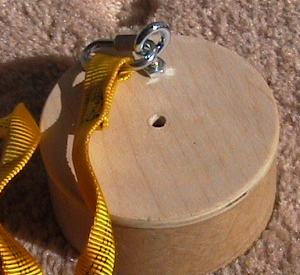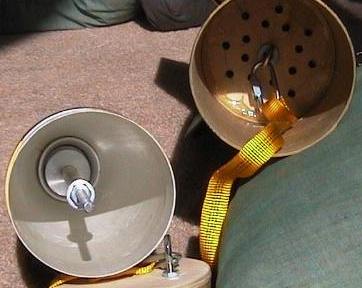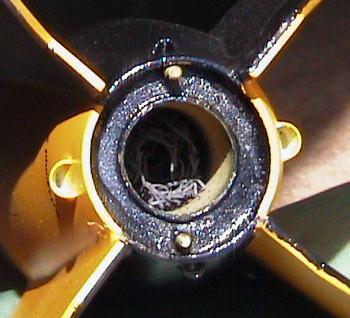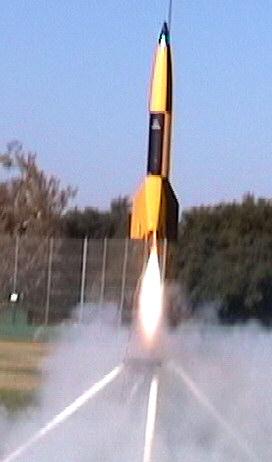| Manufacturer: | Scratch |
 Brief:
Brief:
Scale model of infamous German WWII V-2 in 3.9" dia x 37" tall scale
with 29MM motor mount that can handle up to 29 x 240 hardware. Empty weight of
this rocket is 53 oz including nose cone weights for a G64 RMS. VCP is at
12.7" and CG at 16.8" fully loaded with G64 RMS, tubular nylon shock
chord and 45" ‘chute. The rocket features include wad-less recovery
using ejection charge cooling system, adjustable nose cone weighting and
styrene 1/8 plastic thru-wall fins. Paint finish is the yellow/black White
Sands paint scheme.
Although there are several 3.9" kits available out there, I wanted to control the quality of materials and the design. My main design goals were to creating a close-to-scale V2 that could use different motor sizes in a 29mm motor mount, would be extremely durable and easily repairable.
Component Description:
Body tube material is 3.9" x 8" LOC paper body tube material. Nose
cone and boat tail are made from Ace 3.9" nose cones. Fin material is
1/8" styrene plastic. Used 2 plywood centering rings, one 2" x 29mm,
the other 3.9" x 29mm. Used one 3.9" plywood bulkhead for top of
exhaust cooling compartment. Shock cord made of 12’ nylon tubing with
Quick Link attachments.
 Nose cone followed
the design outlined by
Brian
Kain with some modifications. Glued nose tip cut off boat tail inside of
nose cone with thru-wall screws and epoxy to hold in place. This is used to
support the ¼" All-Thread rod uses for holding weights. Weights
consisting of large washers are held forward with a piece of 5/16" brass
tubing and nut. My bulkhead/coupler assembly is a variation of Brian
Kain’s design and acts as anchor platform for shock chord and nose cone
shoulder base. (See picture)
Nose cone followed
the design outlined by
Brian
Kain with some modifications. Glued nose tip cut off boat tail inside of
nose cone with thru-wall screws and epoxy to hold in place. This is used to
support the ¼" All-Thread rod uses for holding weights. Weights
consisting of large washers are held forward with a piece of 5/16" brass
tubing and nut. My bulkhead/coupler assembly is a variation of Brian
Kain’s design and acts as anchor platform for shock chord and nose cone
shoulder base. (See picture)
Construction/Finishing:
As mentioned in other V2 scratch build articles, cutting the fin slots is
tricky. I used a couple of different fin marking guides to get the spacing
right for marking. I then used the technique recommended by Brian Kain for
cutting the slots. The Dremel tool with dual cutter/spacer configuration worked
well. As mentioned, I used 1/8" styrene plastic purchased as scrap from
Tap Plastic for about $1 per 12" x 8" sheet. Styrene is very easy to
work with. To cut, you just score and snap along a straight edge. To finish,
sand lightly with 200 grit sand paper and you are ready to prime. Styrene saves
me a ton of time in constructing both kits and scratch builds. It is also very
tough, and will withstand a lot of pressure before it breaks. During
construction, I dropped the finished boat tail assembly fins down from 5 feet
onto the concrete floor of my garage with no effect. I have successfully used
1/16" styrene for mid size 2.56" dia models. I much prefer it to ply
or balsa fin material. I have also used 1/8" PVC that is a bit lighter
than styrene, and can be easily sanded and shaped. Its drawback is that it is
not as tough as styrene.
 The
wad-less recovery system incorporates a perforated motor tube, a cooling
compartment between the upper centering ring and a perforated bulkhead. I also
use a steel exhaust cooling mesh ala Aerotech that goes up the motor tube prior
to RMS hardware. The exhaust gasses pass through the steel mesh, through the
perforated motor tube into the cooling compartment and through the perforated
bulkhead into the recovery chamber. This system works very well, and I have
used it successfully in other rockets.
The
wad-less recovery system incorporates a perforated motor tube, a cooling
compartment between the upper centering ring and a perforated bulkhead. I also
use a steel exhaust cooling mesh ala Aerotech that goes up the motor tube prior
to RMS hardware. The exhaust gasses pass through the steel mesh, through the
perforated motor tube into the cooling compartment and through the perforated
bulkhead into the recovery chamber. This system works very well, and I have
used it successfully in other rockets.
I cut the fin size to scale, using a copier to blow up a template of the scale wing template from a 2.56" version I found on the Internet. On the rocket’s first flight, I noticed some spiraling as the rocket approached apogee. I suspect that the smaller fin profile contributed to this as the rocket coasted to apogee.
I attached the 3.9" x 8" length of body tube to the boat tail after finishing both pieces. They were glued together along the interior body tube and top surface of the 3.9" bulkhead using 5 min. epoxy without any filling of the joint. I did this to facilitate the removal of the body tube without trashing the boat tail finish in the event of a recovery malfunction that might damage the body tube. The joint seam is visible between the two parts, but provides some repair flexibility.
Launch lugs are made from 5/16" brass tubing. Two 1" lengths are placed at each end of the 8" body tube. These are glued and filleted in place with 5 min. epoxy. I used a ¼" x 7’ launch rod for this rocket.
 The faux engine gas
exhaust ports are made from styrene plastic tubing cut diagonally and sanded to
match the contour of the boat tail. The fin detail is cut from styrene strips,
sanded and glued to fin surfaces.
The faux engine gas
exhaust ports are made from styrene plastic tubing cut diagonally and sanded to
match the contour of the boat tail. The fin detail is cut from styrene strips,
sanded and glued to fin surfaces.
The paint scheme uses school-bus yellow and black spray paint roughly following the White Sands roll pattern used in 1945. I modified this pattern slightly around the boat tail to make masking around the fins a little easier. I also eliminated the lower chrome band above the fins. I thought I did a good job on the masking, and had nice clean lines between the patterns.
The silver band around the nose cone is chrome-laminated paper that has been cut to follow the contour and angle of the nose cone tip. This is a trial-and-error process using the shroud template tool in VCP. Once I got the right angle set in the tool and printed the template, I traced it onto the chrome-laminated paper for cutting.
I purchased the 3.9" LOC paper body tube, 29 mm motor mount tube, recovery hardware, centering rings and bulkhead from Rocky Mountain Rocketry. All hardware and finishing paint was purchased from my local Orchard Supply Hardware store. The two Ace 3.9" nose cones where purchased off of eBay. The decals where purchased from Papa Tango Decals.
 Flight/Recovery:
Flight/Recovery:
I designed the 29mm motor mount to accommodate up to a 29 x 240 RMS hardware,
but typically will be flying using 40/120 29mm RMS. I built into the base
2" ply centering ring two #8 x ¾" brass machine screws and
fashioned an engine retaining plate made from a piece of brass with holes for
screws and engine nozzle. Small wing nuts are used to secure the brass plate
over the RMS hardware. Flight preparation is a simple matter of dropping in and
securing motor, and then attaching ‘chute to shock cord using a key chain
ring and putting on the NC.
The first flight was on a G64-4W as pictured in this article using a Quick Burst Twiggy igniter. Rocket flight was very stable at launch and acceleration with some spiraling near apogee as rocket slowed to a coast. Estimated altitude per my wrasp calculations was around 600’. Ejection occurred with the rocket starting its decent with good ‘chute deployment using a 45" nylon hemispherical ‘chute. Shock cord is 9/16" x 12’ tubular nylon. Landing occurred about 30 yards down range. Upon recovery inspection, I noticed a slight paint chip at the lower boat tail joint of one fin, but no cracking of the epoxy fin filet. Suspect that there was some movement of the Ace boat tail material that caused some paint delamination upon landing impact. I chose the Ace NC for weight/cost consideration, and the heavier PML NC may be an option for other builders. Other than the paint chip, flight and recovery was perfect.
 Summary:
Summary:
I especially like
Brian
Kain's idea allowing for adjustable weighting of the nose cone to
accommodate different engine loads. I also like the wad-less recovery design
that keeps the rocket interior clean and protects all recovery components. This
is a very impressive looking rocket, especially with the White Sands
yellow/black pattern and decals. I designed this a close to the scale
dimensions as possible to the real thing.
If I could do it all over again, I might have made the fins a bit wider to see if that would increase flight stability. I have a Estes 2.56" version of the V2 with very wide looking fins and it flies great.
As mentioned in other articles, it is important to rough up the NC material with sand paper before priming. Also, be generous with the number of coats of primer, as this will greatly increase the quality of final paint. I used heavy coat gray car primer, followed by white primer, followed by the school bus yellow for all areas. I then used masking tape (the expensive kind!) for masking and painting the black areas. This yielded excellent results, and had no problems with paint leaking or peeling off of finish. After applying decals, I applied a light clear coat finish. I have had much trouble with clear coat either dripping or wrinkling, so I have been very stingy in applying it to my projects.
I estimate that the total cost breakdown looked something like this for this V2:
- Nose cones: $20 for a pair purchased on eBay plus $5 shipping
- Motor tube, centering rings and 9/16" nylon tubing: $12 with shipping
- Used left over 8" piece of 3.9" LOC paper body tubing
- Miscellaneous hardware for NC: $10
- Paints, epoxy and masking tape: $20
- Decals: $13 with shipping
- Scrap 1/8" styrene for fins: $2
Other Reviews
- Scratch V2 By Gary Sinclair
( Contributed - by Gary Sinclair - 11/13/05) Brief: Always a nice rocket to build is the V2. For mine I wanted to use 6" tubing so I could build it around two 6"x19" Scotglas nose cones. (The boat tail is a nose cone with the top missing.) My aim was to build a V2 capable of taking an L motor and dual deployment. Construction: The parts list: 2 19" V2 ...
- Scratch V2 By Brian Kain
( Contributed - by Brian Kain) Brief: Scratch 4" V-2. Flies on H through J 38mm motors. The nose has interchangeable weights so the rocket can be properly weighted for any given motor. I use a silk 36" chute I got from AEROCON. Construction: 1- 4" dia LOC body tube 8.5" long. Glassed with 6oz cloth and 30 min epoxy. This rocket has no payload section ...
Sponsored Ads
 |
 |











